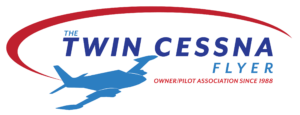414 Prospective Owners

The 414 first flew in 1968 and was certified in 1969. It was a derivative of the 421. Cessna wanted a more cost competitive cabin class aircraft and it was able to achieve this by utilizing parts from the existing 400 series models.
There are two broad categories of 414’s: the early, tip-tanked 414’s and the later model 414A Chancellor’s which had wet wing fuel tanks and other modifications including hydraulically operated landing gear. This landing gear upgrade replaced the electro-mechanical gear in the original model. In addition, the longer nose section, vertical stabilizer and rudder of the 421 were added. The 414 not only lost the tip tanks, but 30 sq. feet of wing area was added. Maximum takeoff weight increased by 400 lbs. and useful load by about 200 lbs. From 1970 to 1977, 508 original 414’s were produced. 739 414A’s were produced from 1978 to 1985.
The original 414’s were powered by TCM TSIO 520-J’s, producing 310 HP. In 1976, the engine was changed to the “N” model and then to the “N” model in 1979. The switch to the NB model was a significant improvement in that this engine had a much improved crankshaft. The TBO was 1,400 hours on the J and N models but was boosted to 1,600 on the NB models.
RAM offers several desirable conversions that boost HP to 335 HP per side. At one time, a liquid-cooled TCM 550 option was offered. Some of these airplanes are still flying. RAM still supports them, but most are slowly being converted back to conventional engines as the liquid cooled engines don’t offer any significant advantages.
Real world speeds depend on engine configuration, but owners typically report 200 kts at about 38 gph in the upper teens. 414’s will typically haul 5 people plus bags and full fuel.
As with all Twin Cessna’s, the landing gear and exhaust systems must be maintained properly. In addition, there is an AD (2005-12-13) on the 414 wing that requires a spar strap at 9,000 hours TT for aircraft with serial # 200 and lower. Serial numbers above 200 have a compliance time of 15,000 hours.
The Cessna 414 is truly one of the best values in the pressurized piston twin market today. Anyone looking to step up from an unpressurized twin or even a high performance single, should give the 414 a serious look.
Model Details
Model: 414
Years Built: 1970 to 1972
Engines: Cont. TSIO-520J 310 HP TBO: 1400 hrs
Cruise Speed: 200 kts
Approximate Useful Load: 2215 lbs
Approximate Price : 115000
Additional Notes: Aircraft introduced
Model: 414
Years Built: 1973 to 1975
Engines: Cont. TSIO-520J 310 HP TBO: 1400 hrs
Cruise Speed: 200 kts
Approximate Useful Load: 2215 lbs
Approximate Price : 120000
Additional Notes: Cabin length increased by 16 inches and 5th side window added
Model: 414
Years Built: 1976 to 1977
Engines: Cont. TSIO-520N 310 HP TBO: 1400 hrs
Cruise Speed: 200 kts
Approximate Useful Load: 2215 lbs
Approximate Price : 170000
Additional Notes: Engine changed to “N” model. Elec. prop synch standard
Model: 414A
Years Built: 1978
Engines: Cont. TSIO-520N 310 HP TBO: 1400 hrs
Cruise Speed: 200 kts
Approximate Useful Load: 2430 lbs
Approximate Price : 225000
Additional Notes: Wing and fuel system changed to wet wing system. Wing area increased. Takeoff weight increased by 400 lbs; useful load by 200 lbs. Nose lengthened similar to 421. Pressurization differential increased to 5 psi. Larger 421 rudder added
Model: 414A
Years Built: 1979 to 1985
Engines: Cont. TSIO-520NB 310 HP TBO: 1600 hrs
Cruise Speed: 200 kts
Approximate Useful Load: 2430 lbs
Approximate Price : 300000
Additional Notes: Switch to NB engine with heavier crankshaft in 1979 and increased TBO. Optional lightweight 100 amp alternators in 1980 as well as heated fuel manifold valve
